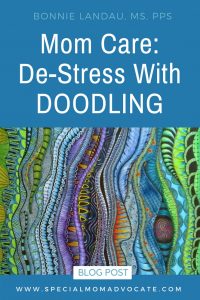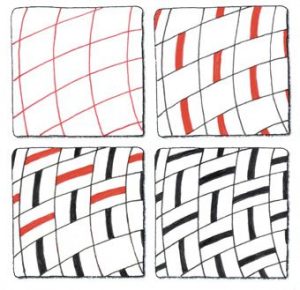 With all the ups and downs that come from being a Special Mom, do you find the time to meditate or calm your spirit? It’s really hard to grab those moments when you can silence your inner voice and reset your energy thermostat. It’s hard to block out the many things going on in your mind, remembering everything you have to do and worrying about not getting it all done.
With all the ups and downs that come from being a Special Mom, do you find the time to meditate or calm your spirit? It’s really hard to grab those moments when you can silence your inner voice and reset your energy thermostat. It’s hard to block out the many things going on in your mind, remembering everything you have to do and worrying about not getting it all done.
That is why I would like to introduce you to Zentangle®, a meditative drawing technique that is so simple. Anybody can learn to do this, even if you have never drawn before. All it requires is pen and paper and willingness to doodle. Yep, doodle. that is what Zentangle is all about. Purposeful doodling that helps distract the mind from its thoughts so you can move your brainwaves into a meditative state without actually meditating.
What is Zentangle?
 This drawing technique was created by Rick Roberts and Maria Thomas (www.zentangle.com). Maria is a calligrapher who realized the act of calligraphy put her into a meditative state. Together Rick and Maria developed the Zentangle method so anybody could experience the meditation of doodling with purpose.
This drawing technique was created by Rick Roberts and Maria Thomas (www.zentangle.com). Maria is a calligrapher who realized the act of calligraphy put her into a meditative state. Together Rick and Maria developed the Zentangle method so anybody could experience the meditation of doodling with purpose.
To learn the method you simply have to follow step-by-step instructions for creating the patterns. While the end result looks complex, the process is actually very simple. There are many books and online tutorials to help you learn. Certified Zentangle Instructors even have classes. I have created a Pinterest board with Zentangle pattern instructions.
 How do you do Zentangle?
How do you do Zentangle?
- Get the proper pens and some paper. Sakura Pigment Micron pens are the ones most often used. You can use any paper, although drawing paper made for ink is going to have the best result for this ink.
- Find a comfortable place to sit. It does not have to be a table. It could be a comfy chair or even a bench in the park.
- Turn on some soothing music. They have CDs especially made for Zentangle, but I find any soothing music will do.
- Draw some random lines criss-crossing on your paper.
- Fill each box in with a pattern. There are a lot of great Zentangle Basics, Expanded Workbook Edition: A Creative Art Form Where All You Need is Paper, Pencil & Pen
Zentangle books you can get to help you learn how to do the patterns.
Here is a great video that shows how to draw a simple Zentangle:
Doing Zentangle provides so many benefits:
 Helps us move into a mindless space. When you are doodling with no end goal, it calms the mind because you are not working towards something. There are no words in the drawing space.
Helps us move into a mindless space. When you are doodling with no end goal, it calms the mind because you are not working towards something. There are no words in the drawing space.- Helps us accept when things don’t go right. You are working in ink, so if you mess up, you just have to go with it. In the beginning this can be very challenging for some people who focus on perfectionism. If you keep practicing though, it’s amazing how freeing it is to just let the mistakes be where they are.
- Improves self-esteem. As you complete the drawings and see how amazing they turn out, you feel better about your ability to do something that looked challenging.
- Can be used to stay calm during stressful event. For example, taking off or landing in an airplane.
- Help reduce habits due to stress. For example, if you find you eat more when you are stressed, you can do some Zentangle until the cravings subside.
- It’s fun! This is really the best part. You can draw random shapes or complex ones, and you can even get coloring books and Zentangle instead of color. It’s just fun to create something so unique.
The heart above was the first Zentangle drawing I ever did. The one to the right was a fun playing with lines drawing that was a great way to practice a lot of patterns.
Enjoy!
ABOUT THE AUTHOR:
Bonnie Landau is a professional counselor and holistic therapist in Ventura County, California. Her specialities include therapy for autism, therapy for ADHD, and therapy for parenting who have kids with autism or ADHD or other neurodivergence. She changed careers from graphic design to counseling with the goal of helping struggling parents of kids with ADHD, autism, or other neurodivergence find strategies and solutions to help their children succeed. Bonnie is also the author of Special Ed Mom Survival Guide: How to Prevail in the Special Education Process and Find Life-long Strategies for You and Your Child.



